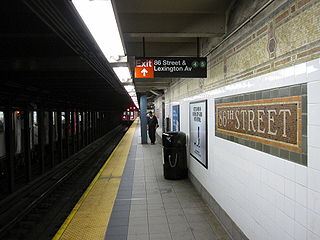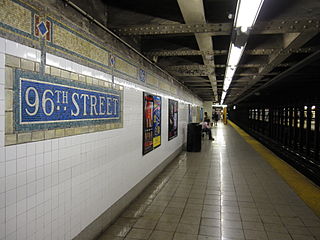
The 68th Street–Hunter College station is a local station on the IRT Lexington Avenue Line of the New York City Subway, located at the intersection of Lexington Avenue and 68th Street on the Upper East Side of Manhattan. It is served by the 6 train at all times, the <6> train during weekdays in the peak direction, and the 4 train during late nights.

The 77th Street station is a local station on the IRT Lexington Avenue Line of the New York City Subway, located at the intersection of Lexington Avenue and 77th Street on the Upper East Side of Manhattan. It is served by the 6 train at all times, the <6> train during weekdays in the peak direction, and the 4 train during late nights.

The 86th Street station is an express station on the IRT Lexington Avenue Line of the New York City Subway. Located at the intersection of Lexington Avenue and 86th Street on the Upper East Side, it is served by the 4 and 6 trains at all times, the 5 train at all times except late nights, and the <6> train during weekdays in peak direction.

The 96th Street station is a local station on the IRT Lexington Avenue Line of the New York City Subway. Located at the intersection of Lexington Avenue and 96th Street in the Carnegie Hill and East Harlem neighborhoods of Manhattan, it is served by the 6 train at all times, the <6> train during weekdays in the peak direction, and the 4 train during late nights.

The 103rd Street station is a local station on the IRT Lexington Avenue Line of the New York City Subway. Located at the intersection of Lexington Avenue and 103rd Street in East Harlem, it is served by the 6 train at all times, the <6> train during weekdays in the peak direction, and the 4 train during late nights.

The 116th Street station is a local station on the IRT Lexington Avenue Line of the New York City Subway. Located at the intersection of Lexington Avenue and 116th Street in East Harlem, it is served by the 6 train at all times, the <6> train during weekdays in the peak direction, and the 4 train during late nights.

The 125th Street station is an express station with four tracks and two island platforms. It is the northernmost Manhattan station on the IRT Lexington Avenue Line of the New York City Subway. Located at Lexington Avenue and East 125th Street in East Harlem, it is served by the 4 and 6 trains at all times, the 5 train at all times except late nights, and the <6> train during weekdays in peak direction. This station was constructed as part of the Dual Contracts by the Interborough Rapid Transit Company and opened in 1918.
The IRT Broadway–Seventh Avenue Line is a New York City Subway line. It is one of several lines that serves the A Division, stretching from South Ferry in Lower Manhattan north to Van Cortlandt Park–242nd Street in Riverdale, Bronx. The Brooklyn Branch, known as the Wall and William Streets Branch during construction, from the main line at Chambers Street southeast through the Clark Street Tunnel to Borough Hall in Downtown Brooklyn, is also part of the Broadway–Seventh Avenue Line. The IRT Broadway–Seventh Avenue Line is the only line to have elevated stations in Manhattan, with two short stretches of elevated track at 125th Street and between Dyckman and 225th Streets.

The Grand Central–42nd Street station is a major station complex of the New York City Subway. Located in Midtown Manhattan at 42nd Street between Madison and Lexington Avenues, it serves trains on the IRT Lexington Avenue Line, the IRT Flushing Line and the 42nd Street Shuttle. The complex is served by the 4, 6, and 7 trains at all times; the 5 and 42nd Street Shuttle (S) trains at all times except late nights; the <6> train during weekdays in the peak direction; and the <7> train during rush hours and early evenings in the peak direction.

The Rector Street station is a station on the IRT Broadway–Seventh Avenue Line of the New York City Subway. Located at the intersection of Rector Street and Greenwich Street in Lower Manhattan, it is served by the 1 train at all times.

The Chambers Street station is an express station on the IRT Broadway–Seventh Avenue Line of the New York City Subway, located at the intersection of Chambers Street and West Broadway in Lower Manhattan. It is served by the 1 and 2 trains at all times, and by the 3 train at all times except late nights.

34th Street–Penn Station is an express station on the IRT Broadway–Seventh Avenue Line of the New York City Subway. Located at the intersection of 34th Street and Seventh Avenue, it is served by the 1 and 2 trains at all times, and the 3 train at all times except late nights. Connections are available to the LIRR, NJ Transit and Amtrak at Pennsylvania Station.

The Franklin Street station is a local station on the IRT Broadway–Seventh Avenue Line of the New York City Subway, located at the intersection of Franklin Street, Varick Street, and West Broadway. It is served by the 1 train at all times and by the 2 train during late nights.

The Central Park North–110th Street station is a station on the IRT Lenox Avenue Line of the New York City Subway, located at the intersection of 110th Street and Lenox Avenue at the southern edge of Harlem, Manhattan. It is served by the 2 and 3 trains at all times.

The 18th Street station is a local station on the IRT Broadway–Seventh Avenue Line of the New York City Subway. Located at the intersection of 18th Street and Seventh Avenue in Manhattan, it is served by the 1 train at all times and by the 2 train during late nights.

The 23rd Street station is a local station on the IRT Broadway–Seventh Avenue Line of the New York City Subway. Located at 23rd Street and Seventh Avenue in Chelsea, Manhattan, it is served by the 1 train at all times and by the 2 train during late nights. The station was built by the Interborough Rapid Transit Company (IRT) as part of the Dual Contracts with New York City, and opened on July 1, 1918. The station had its platforms extended in the 1960s, and was renovated in the 1990s.

The 28th Street station is a local station on the IRT Broadway–Seventh Avenue Line of the New York City Subway. Located at the intersection of 28th Street and Seventh Avenue in Manhattan, it is served by the 1 train at all times and by the 2 train during late nights.

The Canal Street station is a local station on the IRT Broadway–Seventh Avenue Line of the New York City Subway, located in Lower Manhattan at the intersection of Canal and Varick Streets. It is served by the 1 train at all times and by the 2 train during late nights.

The Houston Street station is a local station on the IRT Broadway–Seventh Avenue Line of the New York City Subway. Located at West Houston and Varick Streets in Greenwich Village, Manhattan, it is served by the 1 train at all times and by the 2 train during late nights.

The Christopher Street–Sheridan Square station is a local station on the IRT Broadway–Seventh Avenue Line of the New York City Subway. Located at the intersection of Christopher Street and Seventh Avenue South in Manhattan, it is served by the 1 train at all times and by the 2 train during late nights.























